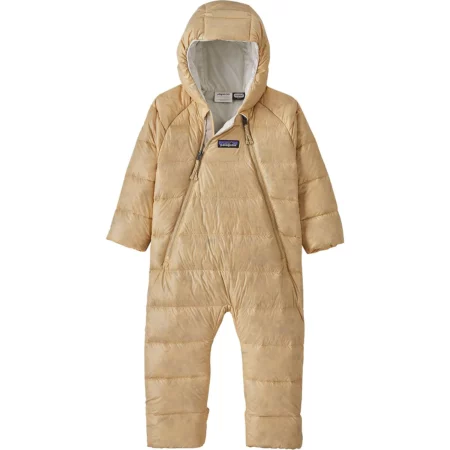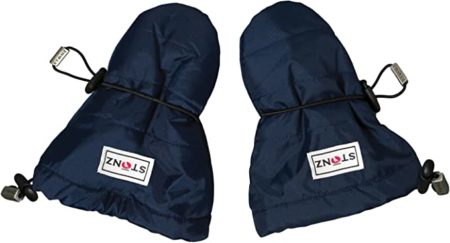How cold is *too* cold for a baby to go outside?
We have the answer, mama.

We independently select and share the products we love—and may receive a commission if you choose to buy.
In This Article
As the days get shorter, in addition to facing freezing temperatures, parents have the extra challenge of coming up with winter activities for their kids—and themselves—during these long, dark, cold months.
Heading outside is such an amazing activity for everyone from newborns through adults—but what about when it’s absolutely freezing? How cold is too cold for a baby? Can you safely take your sweet little bundle outdoors?
The answer is: Maybe.
Children, especially babies, are more sensitive to temperature changes than adults. “Because they are less able to regulate their body temperature than adults, children can quickly develop a dangerously low body temperature [i.e., become hypothermic]. Newborn infants are prone to hypothermia [defined as a body temperature of below 95º F], because of their large body surface area, small amount of subcutaneous fat, and decreased ability to shiver,” says The American Academy of Pediatrics (AAP).
You’re not overreacting by being nervous about taking your infant outside in freezing temps. The good news? There are ways to do it safely.
How to dress your baby for cold weather
To keep warm in the winter, layers are the key—for both babies and adults. But it’s very important not to overheat your baby by putting on too many layers—since overheating is dangerous for babies, too.
The general rule of thumb is that your baby should be dressed in one more layer than you feel comfortable in. If you are happy with one long-sleeve shirt, your baby should probably have a long-sleeve onesie, plus another shirt or light jacket on top.
If you’re going for a stroller walk, dress baby warmly, then add a blanket or stroller cozy to keep them all snuggled up.
Related: The best winter gear for kids: 9 must-haves from our editor who lives in Alaska
When playing outside, in addition to a winter coat and warm pants or snow pants, don’t forget a hat and mittens. The most vulnerable parts of a little body are the extremities, like their chin, nose, ears, fingers and toes.
Remember, car seat safety is of utmost importance, even as you try to keep baby warm. Babies should not wear a winter coat, very thick clothing or blankets under the straps of their car seats—the straps will not cinch tightly enough around the baby if they do, which is unsafe in a crash.
Is 30 degrees too cold for baby? What outside temperature is too cold for baby
Above freezing: Extreme cold starts to become a factor when the temperature drops below freezing (32º F). You can still go outside, but it should not be for very long.
Well-below freezing: Once temperatures start to drop below 20º F, it’s best to stay inside if you can. Be sure to factor in wind chill when you’re checking the weather—the wind can feel much, much colder, especially on sensitive baby skin.
Indoors: When you’re inside, the ideal temperature for your thermostat to be set at is 68º to 72º. Remember that baby blankets, although super cute for snuggling baby in our arms, are not safe for the crib as they pose a risk for sudden infant death syndrome (SIDS). If you’re concerned about baby being cold at night, we recommend sleep sacks.
Symptoms to watch out for
Keep a close eye on your baby (we know you always do) when you’re playing outside. According to the Mayo Clinic, if you see any of these symptoms develop, give your pediatrician a call right away (or just call 911):
Symptoms of hypothermia in infants and children
- Shivering (note, young babies don’t shiver!)
- Slurred speech
- Slow, shallow breathing
- Weak pulse
- Clumsiness
- Sleepy or very low energy
- Confusion or memory loss
- Loss of consciousness
- Bright red, cold skin (in babies)
Symptoms of frostbite in infants and children
- Cold skin
- Prickly, pins-and-needle feeling
- Numbness
- Red, white, bluish-white or grayish-yellow skin
- Hard or waxy skin
- Clumsiness and stiffness
- Blistering
A few other safety tips for taking care of babies in the winter
- Have an emergency kit in your car in case you break down. Edmunds has a great emergency kit list of things like blankets, flashlights, granola bars and bottled water. You’ll also want to make sure your gas tank is near full and the car’s maintenance is up to date to avoid issues.
- Consider pre-warming your car, but NEVER in a garage—even an open one.
- Protect everyone’s skin with baby-safe lotion or balms.
- Consider using a cool-mist humidifier to keep baby’s air moist at night.
Related: 8 must-have products to help mamas & babies survive the winter
A note from Motherly
You can certainly still take baby outside, it’s just safest to stay aware of the temperature. Dress babies in layers, follow safe carseat guidelines, and watch closely for any signs that baby is too cold. Don’t stay out for too long, and if it’s less than 20º F, avoid going outside at all (a quick walk to a preheated car is OK).
Hang in there, mama. You’re not doing it wrong—this season can be hard. Go into hibernation mode, focus on some real self-care and snuggles, and before you know it, the flowers will be in bloom and you’ll be spending every waking second outside.
Wondering how to dress your baby for cold weather? Here's what you need.
A version of this article was originally published November 12, 2019. It has been updated.










